Mini-Satellite Fucheng 1 SAR: Interferometry to Monitor Mining-Induced Subsidence and Comparative Analysis with Sentinel-1
Abstract
:1. Introduction
2. Study Area and Datasets
2.1. Study Area
2.2. Datasets
3. Methods
4. Results
4.1. Fucheng 1 D-InSAR Results
4.2. Fucheng 1 Stacking-InSAR Results
5. Discussion
5.1. Comparative Analysis of Multi-Platform SAR Images Interference
5.2. Comparative Analysis of Time-Series Results
6. Conclusions
- (1)
- Fucheng 1 demonstrates superior visibility of subsidence within the study area, accompanied by a higher coherence. In comparison to Sentinel-1A, the shorter vertical baseline of Fucheng-1 enhances the interferometric quality of its interferograms. Consequently, the percentage of areas exhibiting good coherence within the two sets of typical interferometric pairs is higher for Fucheng 1 than for Sentinel-1A.
- (2)
- Utilizing a subsidence rate threshold of <−15 mm/year, a total of seven subsidence sites characterized by high regional deformation rates were identified within the study area. These sites are extensively distributed and numerous. The spatial distribution of the subsidence features, as inferred from the SAR imagery of both satellites, is found to be analogous. Furthermore, the monitored subsidence rates from the two satellites are largely consistent with one another, with a maximum monitoring discrepancy of less than 5 mm/year within the same area, barring any anomalies in “area a”.
- (3)
- Addressing the issue of significant discrepancies in the magnitude of deformation monitored by the two satellites within the a-region, this study introduces the concept of the MDDG. It is demonstrated that, as the tilt resolution improves, the MDDG capability of the Fucheng 1 satellite is enhanced by a factor of 2.15 relative to that of Sentinel-1A, which reveals the reasons for the differences in the subsidence values of the two satellites in “area a”.
Author Contributions
Funding
Data Availability Statement
Conflicts of Interest
References
- Zhang, Z.; Zeng, Q.; Yang, L. Monitoring of Surface Deformation in Mining Areas Using an Adaptive DS-InSAR Method Combined with Land Cover Types. J. Univ. Pekin. 2024, 60, 265–276. [Google Scholar] [CrossRef]
- Xiao, H.; Yin, M.; Jiang, Y.; Yang, J. Development, Current Status, and Prospects of China’s National Coal Standards. China Stand. 2004, 4, 24–26. [Google Scholar]
- Yang, X.; Niu, Y.; Zhang, Z.; Zhang, P.; Liu, K. Research on Mine Subsidence Monitoring using SBAS-InSAR Integrated with UAV-derived DEM: A Case Study in a Mining Area in Wu’an. Prog. Earth Planet. Sci. 2024, 39, 38–47. [Google Scholar]
- Przyłucka, M.; Kowalski, Z.; Perski, Z. Twenty years of coal mining-induced subsidence in the Upper Silesia in Poland identified using InSAR. Int. J. Coal Sci. Technol. 2024, 9, 86. [Google Scholar] [CrossRef]
- Chang, Y.; Xu, X.; Wang, Z.; Yang, P.; Liu, H.; Zhang, Y. Hydrogeological Support in the Disaster Relief of the “12·25” Gypsum Mine Collapse Accident in Pingyi, Shandong Province. Chin. J. Geol. Hazard Control. 2018, 29, 67–71. [Google Scholar]
- Feng, F.; Jing, P. Multi-stakeholder Emergency Collaborative Governance in the Context of Unexpected Events: Problems and Optimizations—A Case Study of the “2·22” Coal Mine Collapse Accident in Alashan, Inner Mongolia. City Disaster Reduct. 2024, 1, 54–59. [Google Scholar]
- Qian, J. Collapse of a Gold Mine in Tanzania Kills at Least 21 People and Leaves Many Missing. CCTV News. 2024. Available online: https://news.cctv.cn/2024/01/14/ARTICDXx1ybdMjLt6urU8Hg7240114.shtml (accessed on 20 March 2024).
- Xia, Y. CR-Based SAR-Interferometry for Landslide Monitoring. In Proceedings of the IGARSS 2008-2008 IEEE International Geoscience and Remote Sensing Symposium, Boston, MA, USA, 6–11 July 2008; Volume 2, p. II-1239. [Google Scholar]
- Wang, T. Time-Series InSAR Analysis over the Three Gorges Region: Techniques and Applications. Ph.D. Thesis, Wuhan University, Wuhan, China, 2010. [Google Scholar]
- Xu, Q.; Yuan, Y.; Zeng, Y.; Hack, R. Some New Pre-warning Criteria for Creep Slope Failure. Sci. China Technol. Sci. 2015, 54, 210–220. [Google Scholar] [CrossRef]
- Li, Z.; Song, C.; Yu, C.; Xiao, R.; Chen, L.; Luo, H.; Dai, K.; Ge, D.; Ding, Y.; Zhang, Y.; et al. Application and Challenges of Satellite Radar Remote Sensing in Landslide Detection and Monitoring. Geo. Inf. Sci. Wuhan Univ. 2019, 44, 967–979. [Google Scholar]
- Strozzi, T.; Klimeš, J.; Frey, H.; Caduff, R.; Huggel, C.; Wegmüller, U.; Rapre, A.C. Satellite SAR Interferometry for the Improved Assessment of the State of Activity of Landslides: A Case Study from the Cordilleras of Peru. Remote Sens. Environ. 2018, 217, 111–125. [Google Scholar] [CrossRef]
- Liu, P.; Li, Z.; Hoey, T.; Kincal, C.; Zhang, J.; Zeng, Q.; Muller, J.P. Using Advanced InSAR Time Series Techniques to Monitor Landslide Movements in Badong of the Three Gorges Region, China. Int. J. Appl. Earth Obs. Geoinf. 2013, 21, 253–264. [Google Scholar] [CrossRef]
- Dai, K.; Li, Z.; Xu, Q.; Bürgmann, R.; Milledge, D.G.; Tomas, R.; Fan, X.; Zhao, C.; Liu, X.; Peng, J.; et al. Entering the era of Earth-Observation Based Landslide Warning System. IEEE Geosci. Remote Sens. Mag. 2020, 8, 136–153. [Google Scholar] [CrossRef]
- Wang, G.; Li, P.; Li, Z.; Liu, J.; Zhang, Y.; Wang, H. InSAR and Machine Learning Reveal New Understanding of Coastal Subsidence Risk in the Yellow River Delta, China. Sci. Total Environ. 2024, 915, 170203. [Google Scholar] [CrossRef] [PubMed]
- Liang, R.; Dai, K.; Xu, Q.; Pirasteh, S.; Li, Z.; Li, T.; Wen, N.; Deng, J.; Fan, X. Utilizing Full Polarimetric SAR to Map Coseismic Landslides Inventory of the 2017 Mw 7.0 Jiuzhaigou Earthquake (China). Int. J. Appl. Earth Obs. Geoinf. 2024, 127, 103657. [Google Scholar]
- Liao, M.; Dong, J.; Li, M.; Ao, M.; Lu, Z.; Shi, X. Landslide Hazard Identification and Deformation Monitoring Using Radar Remote Sensing. J. Remote Sens. 2021, 25, 332–341. [Google Scholar]
- Zhou, H.; Dai, K.; Pirasteh, S.; Li, R.; Xiang, J.; Li, Z. InSAR Spatial-heterogeneity Tropospheric Delay Correction in Steep Mountainous Areas Based on Deep Learning for Landslides Monitoring. IEEE Trans. Geosci. Remote Sens. 2023, 61, 1–14. [Google Scholar] [CrossRef]
- Li, G.; Zhang, R.; Liu, G.; Yu, B.; Zhang, B.; Dai, K.; Bao, J.; Wei, B. Sentinel-1A TS-DInSAR Monitoring and Analysis of Subsidence in the Beijing-Tianjin-Hebei Region. J. Remote Sens. 2018, 22, 633–646. [Google Scholar]
- Qu, F.; Zhang, Q.; Lu, Z.; Zhao, C.; Yang, C.; Zhang, J. Land Subsidence and Ground Fissures in Xi’an, China 2005–2012 Revealed by Multi-Band InSAR Time-Series Analysis. Remote Sens. Environ. 2014, 155, 366–376. [Google Scholar] [CrossRef]
- Dai, K.; Chen, C.; Shi, X.; Wu, M.; Feng, W.; Xu, Q.; Liang, R.; Zhuo, G.; Li, Z. Dynamic Landslides Susceptibility Evaluation in Baihetan Dam area during extensive impoundment by integrating Static Geological Model and InSAR Observations. Int. J. Appl. Earth Obs. Geoinf. 2023, 116, 103157. [Google Scholar]
- Yang, C.S.; Dong, J.H.; Zhu, S.N.; Xiong, G.H. Detection, Identification, and Deformation Characteristics of Landslide Groups by InSAR in Batang Section of Jinsha River Convergence Zone, China. J. Earth Sci. Environ. 2021, 43, 398–408. [Google Scholar]
- Zhang, C.; Li, Z.; Yu, C.; Song, C.; Xiao, R.; Peng, J. Landslide Detection of the Jinsha River Region Using GACOS Assisted InSAR Stacking. Geosci. Inf. Sci. Wuhan Univ. 2021, 6, 1649–1655. [Google Scholar]
- Zhang, Z.; Feng, W.; Xu, X.; Samsonov, S. Performance of Common Scene Stacking Atmospheric Correction on Nonlinear InSAR Deformation Retrieval. Remote Sens. 2023, 15, 5399. [Google Scholar] [CrossRef]
- Chen, Y.; Dong, X.; Qi, Y.; Huang, P.; Sun, W.; Xu, W.; Tan, W.; Li, X.; Liu, X. Integration of D-InSAR-PS-Stacking and SBAS-PS-InSAR Methods to Monitor Mining-Related Surface Subsidence. Remote Sens. 2023, 15, 2691. [Google Scholar] [CrossRef]
- Zhang, L.; Dai, K.; Deng, J.; Ge, D.; Liang, R.; Li, W.; Xu, Q. Identifying potential landslides by stacking-InSAR in southwestern China and its performance comparison with SBAS-InSAR. Remote Sens. 2021, 13, 3662. [Google Scholar] [CrossRef]
- Wen, N.; Dai, K.; Deng, J.; Liu, C.; Liang, R.; Yu, B.; Feng, W. Periodic displacement accurate extraction of reservoir active slopes through InSAR observation and independent component analysis based wavelet transform. Int. J. Appl. Earth Obs. Geoinf. 2024, 130, 103919. [Google Scholar] [CrossRef]
- Dai, H.; Zhang, H.; Dai, H.; Wang, C.; Tang, W.; Zou, L.; Tang, Y. Landslide identification and gradation method based on statistical analysis and spatial cluster analysis. Remote Sens. 2022, 18, 4504. [Google Scholar] [CrossRef]
- Wang, L. Monitoring and Risk Assessment of Hazard Sources in Tailings Reservoirs Based on Multi-Source Data Coupling. Master’s Thesis, Chengdu University Technology, Chengdu, China, 2019. [Google Scholar]
- Yang, G.; Zhu, L.; Zhang, L. Application of Stacking-InSAR Technique in Surface Subsidence Monitoring of Mining Area. Mine Surv. 2021, 49, 98–102+119. [Google Scholar]
- Li, Q. Research on the Application of Time-Series InSAR Technology in Mining Subsidence Monitoring. Master’s Thesis, Xian University Science Technology, Xian, China, 2021. [Google Scholar]
- Chang, Z.; Liu, X.; Xue, T.; Yang, R. Investigating Ground Subsidence in Beijing by Using Interferogram Stacking InSAR. IEEE Int. Conf. Spat. Data Mining Geogr. Know. Serv. 2011, 3, 378–380. [Google Scholar]
- Zhang, Y. Research on InSAR Monitoring of Surface Subsidence in Peibei Mining Area. Master’s Thesis, China University Mining Technology, Beijing, China, 2016. [Google Scholar]
- Jin, B.; Zeng, T.; Wang, T.; Zhang, Z.; Gui, L.; Yin, K.; Zhao, B. Advanced risk assessment framework for land subsidence impacts on transmission towers in salt lake region. Environ. Model. Softw. 2024, 177, 106058. [Google Scholar] [CrossRef]
- Zeng, T.; Wu, L.; Hayakawa, Y.S.; Yin, K.; Gui, L.; Jin, B.; Guo, Z.; Peduto, D. Advanced integration of ensemble learning and MT-InSAR for enhanced slow-moving landslide susceptibility zoning. Eng. Geol. 2024, 331, 107436. [Google Scholar] [CrossRef]
- Yu, B.; Niu, T.; Zhao, J.; Ma, D.; Liu, G.; Wang, X.; Dai, K.; Gu, Y. Long-term Deformation Monitoring of Karamay Oilfield using SBAS-DInSAR. J. SW Petroleum Univ. 2022, 44, 23–34. [Google Scholar]
- Song, Z.; Tan, C.; Liu, S.; Wu, S.; Gao, X.; Tan, J.; Dai, C.; Luo, Z. Study on the Reserve Distribution and Extraction Degree of Non-homogeneous Conglomerate Reservoirs—A Case Study of Keshang Group Reservoirs in Karamay Oilfield. Xinjiang Pet. Geol. 2001, 22, 335–337. [Google Scholar] [CrossRef]
- Liu, H.; Li, X.; Gu, Y.; Zhang, Y. From ‘Oil-dominated’ to ‘Primary and Diversified’. Econ. Info. Daily 2023, 6. [Google Scholar]
- Li, X.; Li, W.; Gao, B.; Yang, D. Research on Karamay Oilfield Seven Central Carboniferous Reservoir Water Injection Development Characteristic. Xinjiang Oil Gas 2012, 8, 57–59. [Google Scholar]
- Zhang, J.; Tan, F.; Wang, X.; Qin, M.; Li, X. Mobilization Patterns of Crude Oil in Complex Pores under Different Displacement Modes: A Case Study of the Badaowang Formation Reservoir in Wellblock 530, Karamay Oilfield. J. Xian Petroleum Univ. 2022, 37, 58–65. [Google Scholar]
- Guo, R.; Yin, Q. Launching into Space! ‘Mianyang Constellation’ First Satellite ‘Fucheng-1’ is on Its Way. Mianyang Daily. 2024. Available online: https://www.thepaper.cn/newsDetail_forward_22684753 (accessed on 20 March 2024).
- Yu, H.; Li, B.; Xiao, Y.; Sun, J.; Chen, C.; Jin, G.; Liu, H. Surface Subsidence over a Coastal City Using SBAS-InSAR with Sentinel-1A Data: A Case of Nansha District, China. Remote Sens. 2023, 16, 1. [Google Scholar] [CrossRef]
- Wu, W.; Li, T.; Long, S.; Zhou, Z. Coregistration of Sentinel-1 TOPS Data for Interferometric Processing Using Real-Time Orbit. Geomat. Inf. Sci. Wuhan Univ. 2019, 44, 745–750. [Google Scholar]
- Yin, Y. Fucheng 1 Completed the Single-satellite Heavy Orbit Interferometry Test, and the Key Technical Indicators of the Satellite Have Reached the International Advanced Level. Changsha Evening News. 2024. Available online: https://hunan.voc.com.cn/article/202312/202312060920305798.html (accessed on 20 March 2024).
- Zhang, L.; Gao, P.; Gan, Z.; Wu, W.; Sun, Y.; Zhu, C.; Long, S.; Liu, M.; Peng, H. Surface Subsidence Monitoring of Mining Areas in Hunan Province Based on Sentinel-1A and DS-InSAR. Sensors 2023, 23, 19. [Google Scholar] [CrossRef]
- Farr, T.G.; Rosen, P.A.; Caro, E.; Crippen, R.; Duren, R.; Hensley, S.; Kobrick, M.; Paller, M.; Rodriguez, E.; Roth, L.; et al. The Shuttle Radar Topography Mission. Rev. Geophys. 2007, 45, RG2004. [Google Scholar] [CrossRef]
- Chen, B.; Deng, K.; Fan, H. Monitoring and Prediction of Mining Subsidence Based on D-InSAR Technology and SVR Algorithm. J. China Univ. Mining Tech. 2014, 43, 880–886. [Google Scholar]
- Deng, J.; Dai, K.; Liang, R.; Chen, L.; Wen, N.; Zheng, G.; Xu, H. Interferometric Synthetic Aperture Radar Applicability Analysis for Potential Landslide Identification in Steep Mountainous Areas with C/L Band Data. Remote Sens. 2023, 15, 4538. [Google Scholar] [CrossRef]
- Han, Y.; Li, T.; Dai, K.; Lu, Z.; Yuan, X.; Shi, X.; Liu, C.; Wen, N.; Zhang, X. Revealing the Land Subsidence Deceleration in Beijing (China) by Gaofen-3 Time Series Interferometry. Remote Sens. 2023, 15, 3665. [Google Scholar] [CrossRef]
- Ferretti, A. Satellite InSAR Data: Reservoir Monitoring from Space (EET 9). EAGE, 1 January 2014.
- Wang, Q.J.; Li, Z.W.; Du, Y.N.; Xie, R.A.; Zhang, X.Q.; Jiang, M.; Zhu, J.J. Generalized Functional Model of Maximum and Minimum Detectable Deformation Gradient for PALSAR Interferometry. Trans. Nonferrous Metals Soc. China 2014, 24, 824–832. [Google Scholar] [CrossRef]
- Dai, K.; Chen, Y.; Xu, Q.; Hancock, C.; Jiang, M.; Deng, J.; Zhuo, G. A Functional Model for Determining Maximum Detectable Deformation Gradients of InSAR Considering the Topography in Mountainous Areas. IEEE Trans. Geosci. Remote Sens. 2023, 61, 5211211. [Google Scholar] [CrossRef]

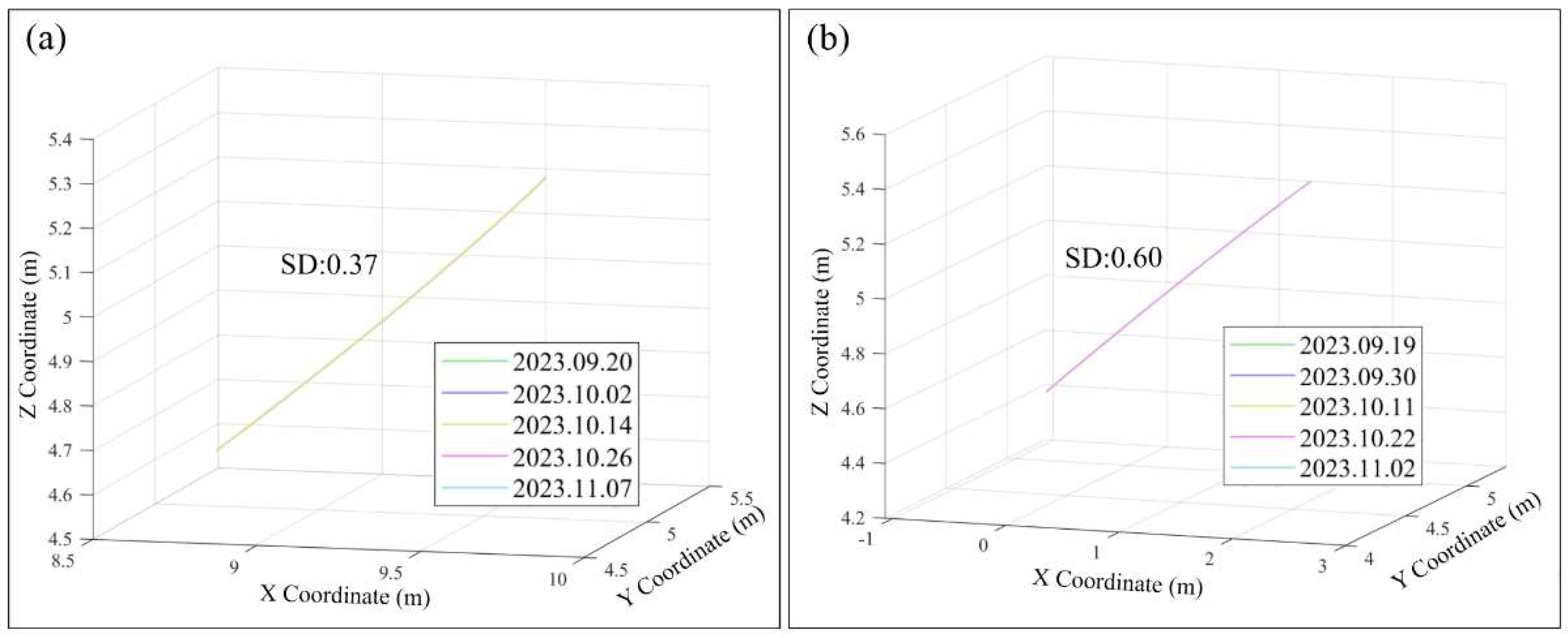
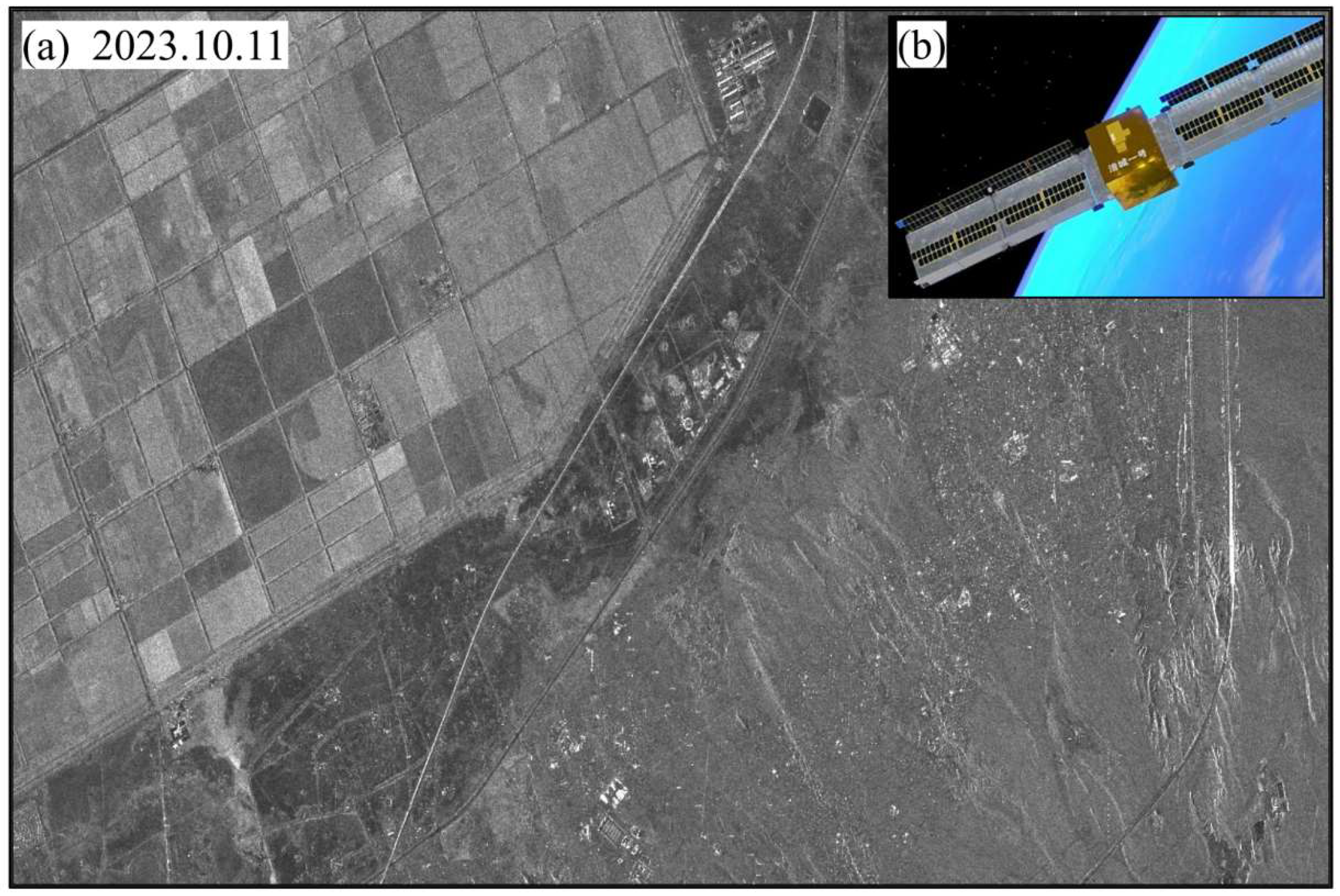

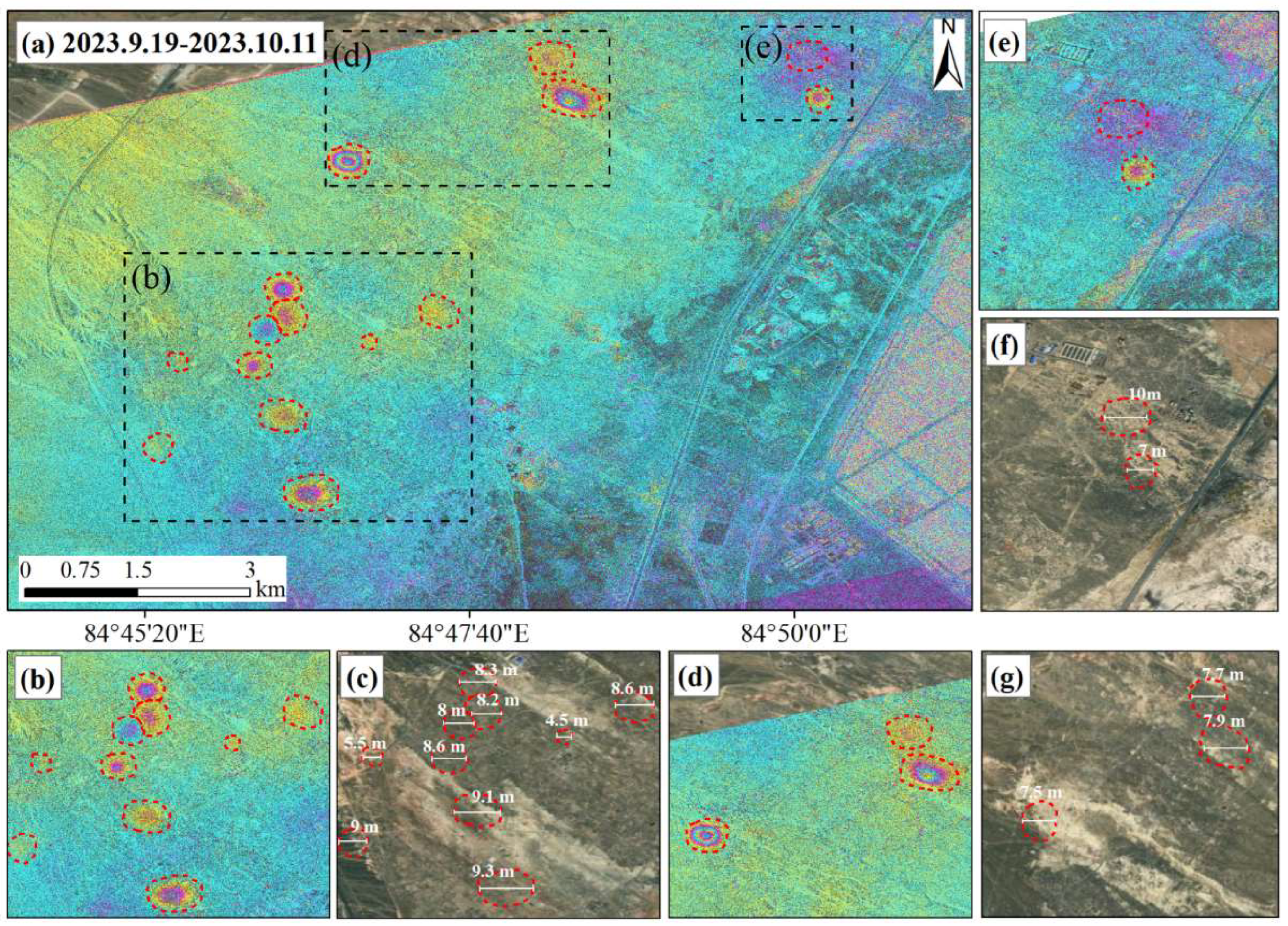
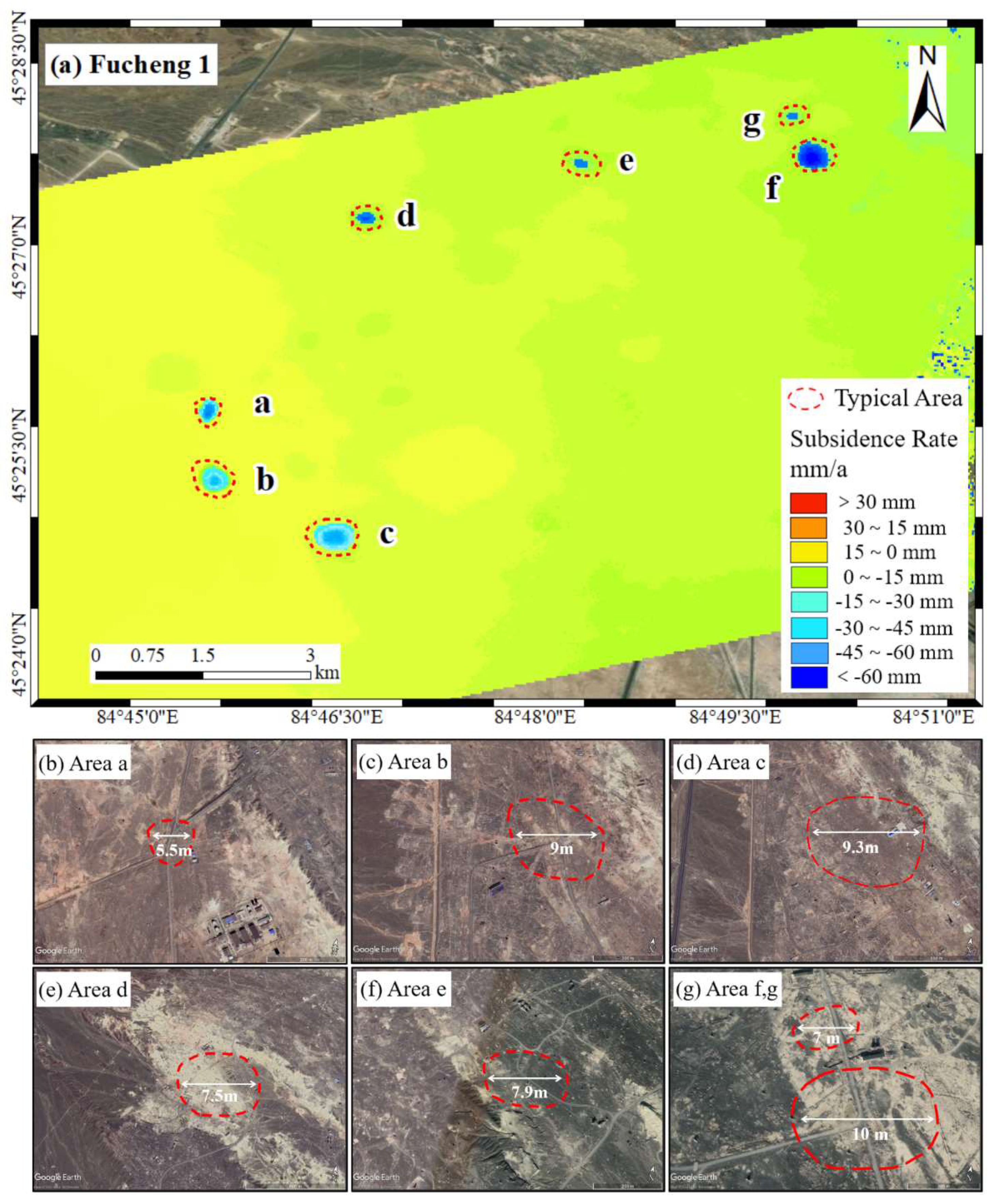
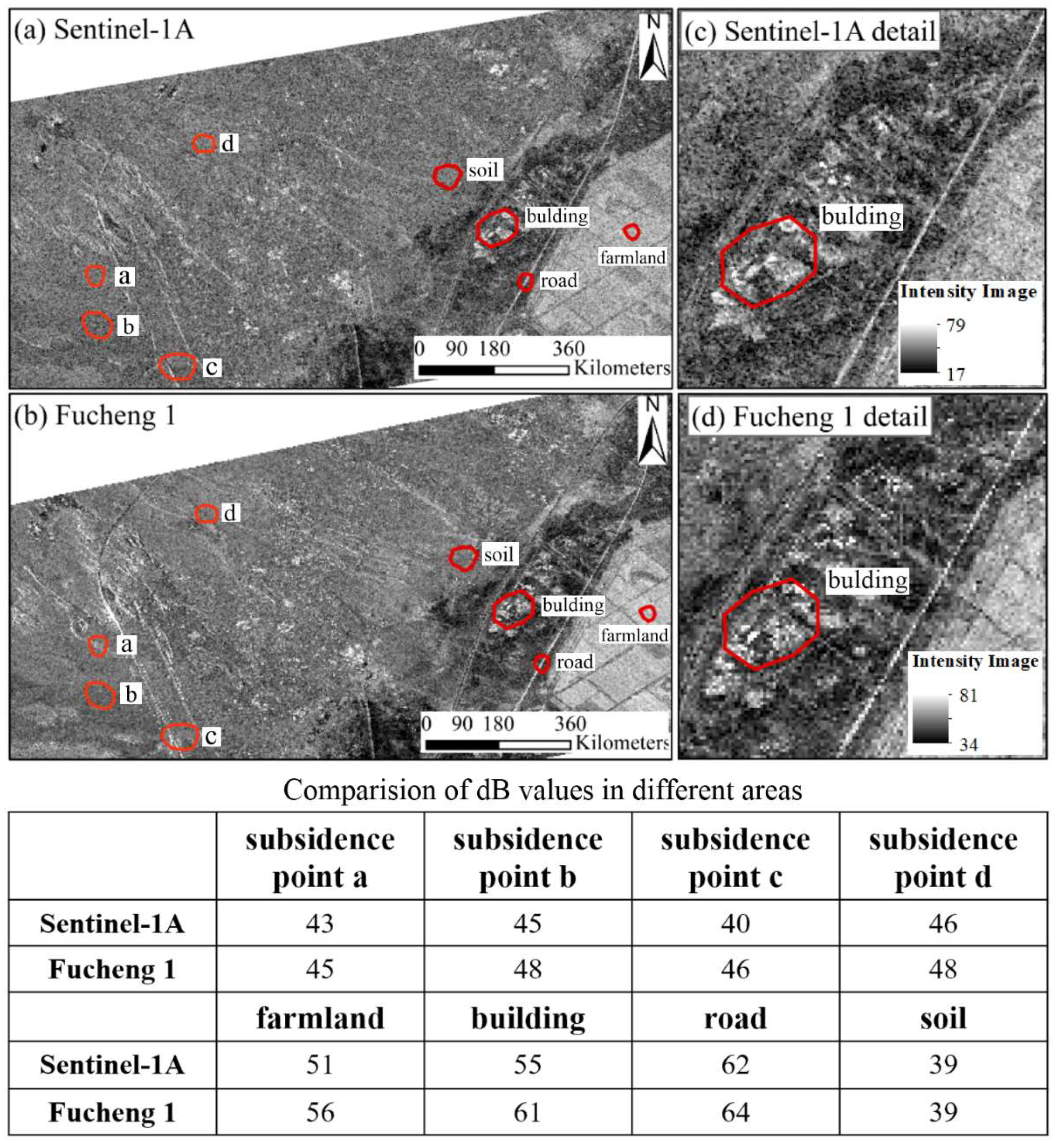
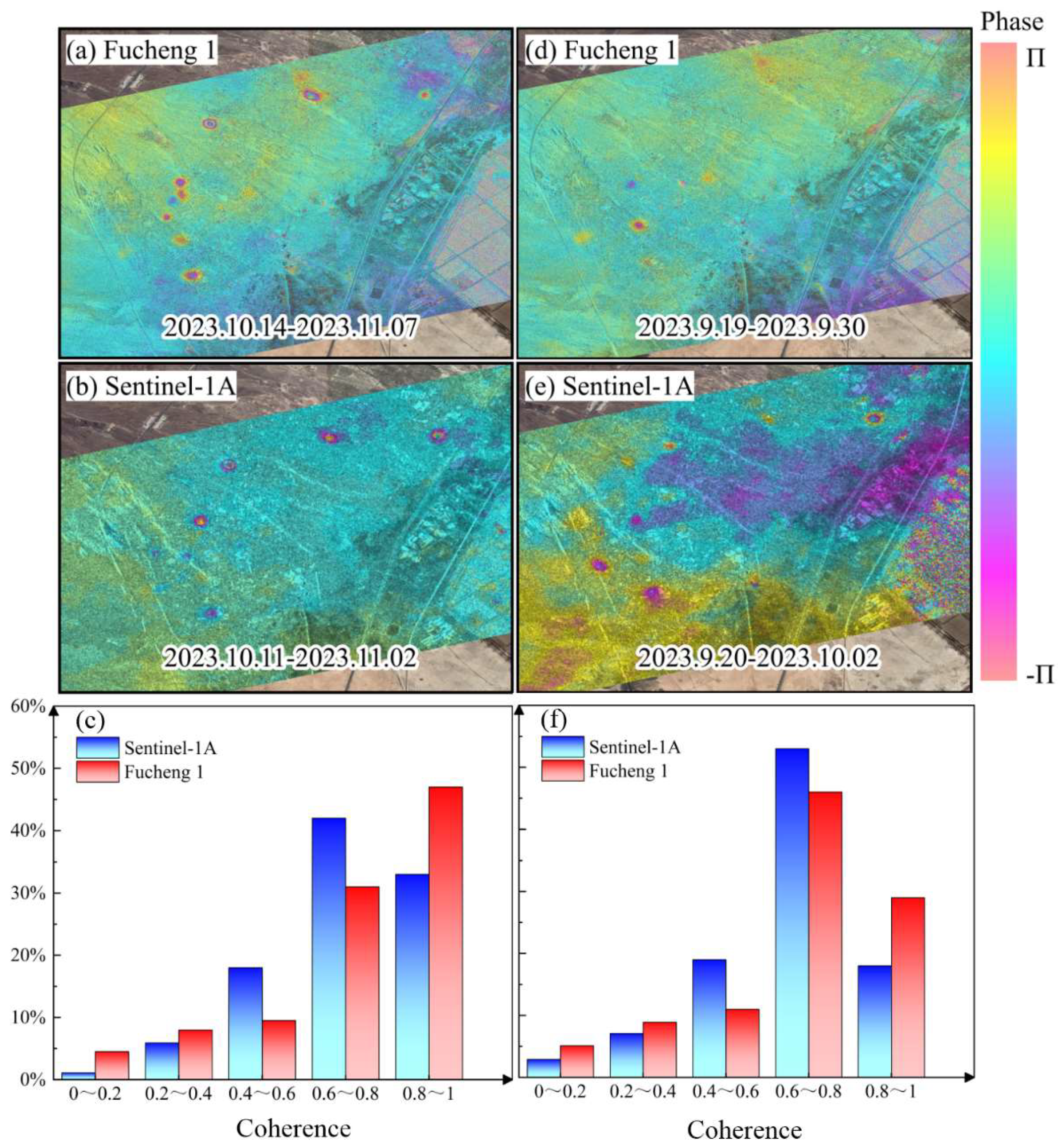
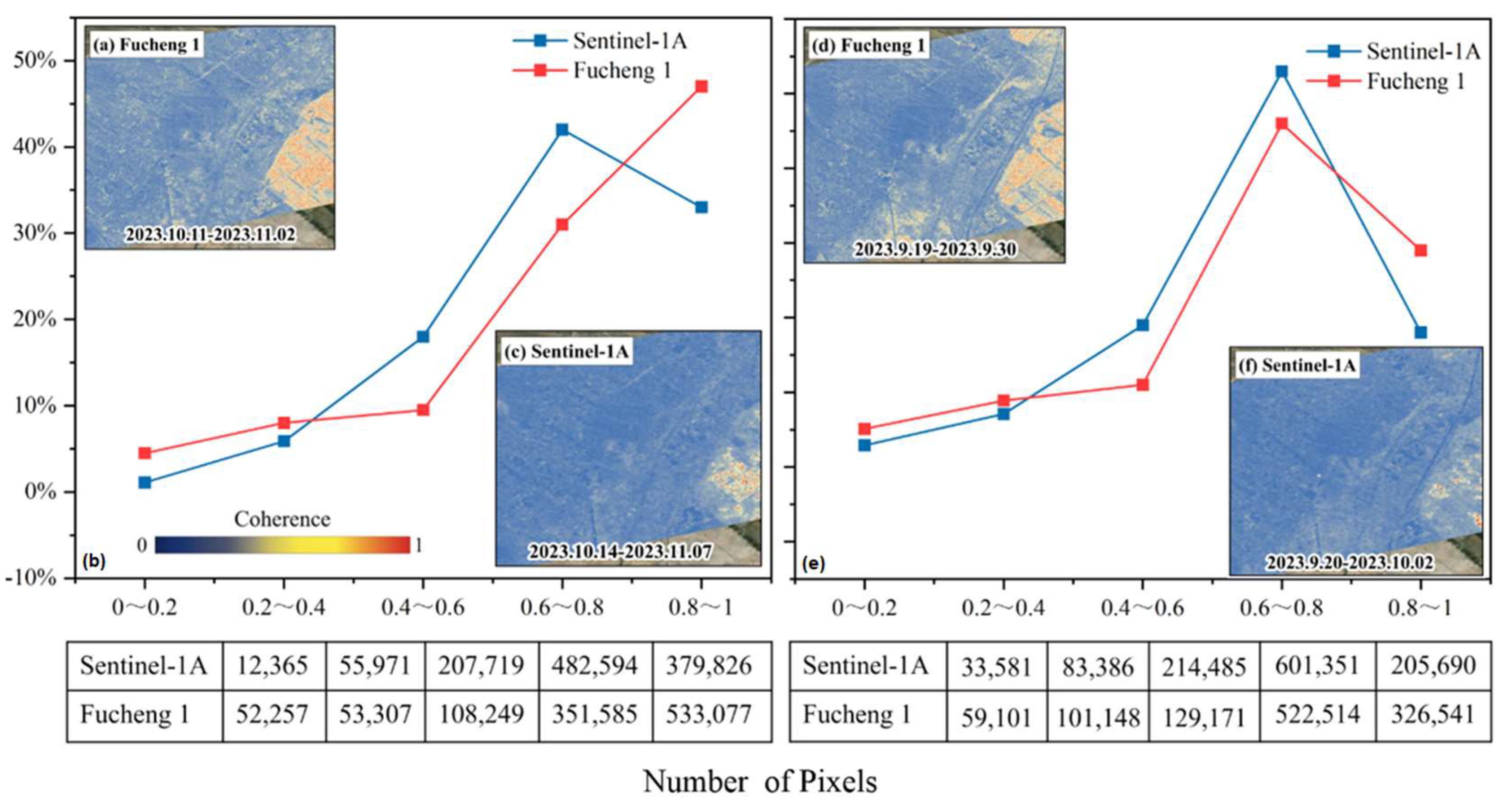

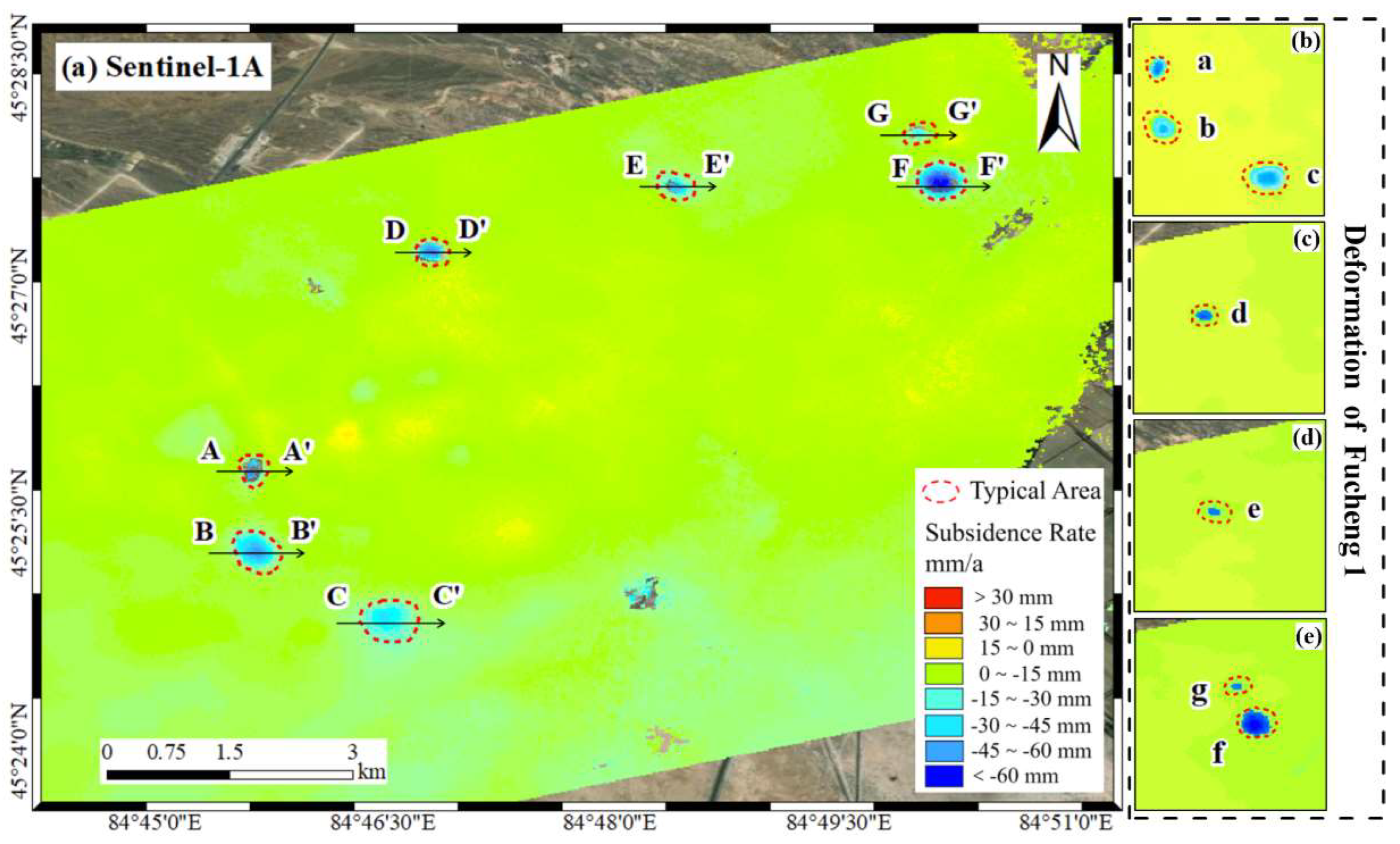
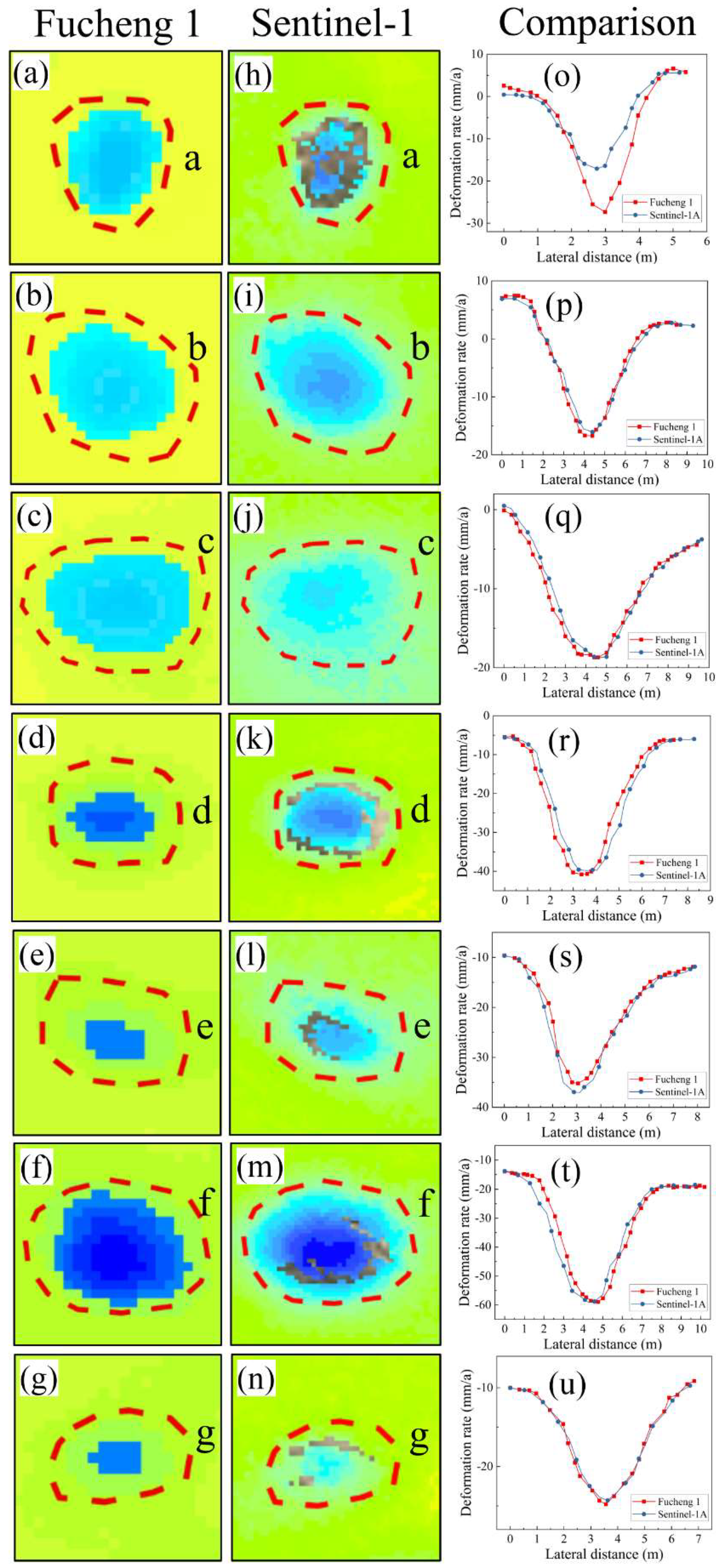
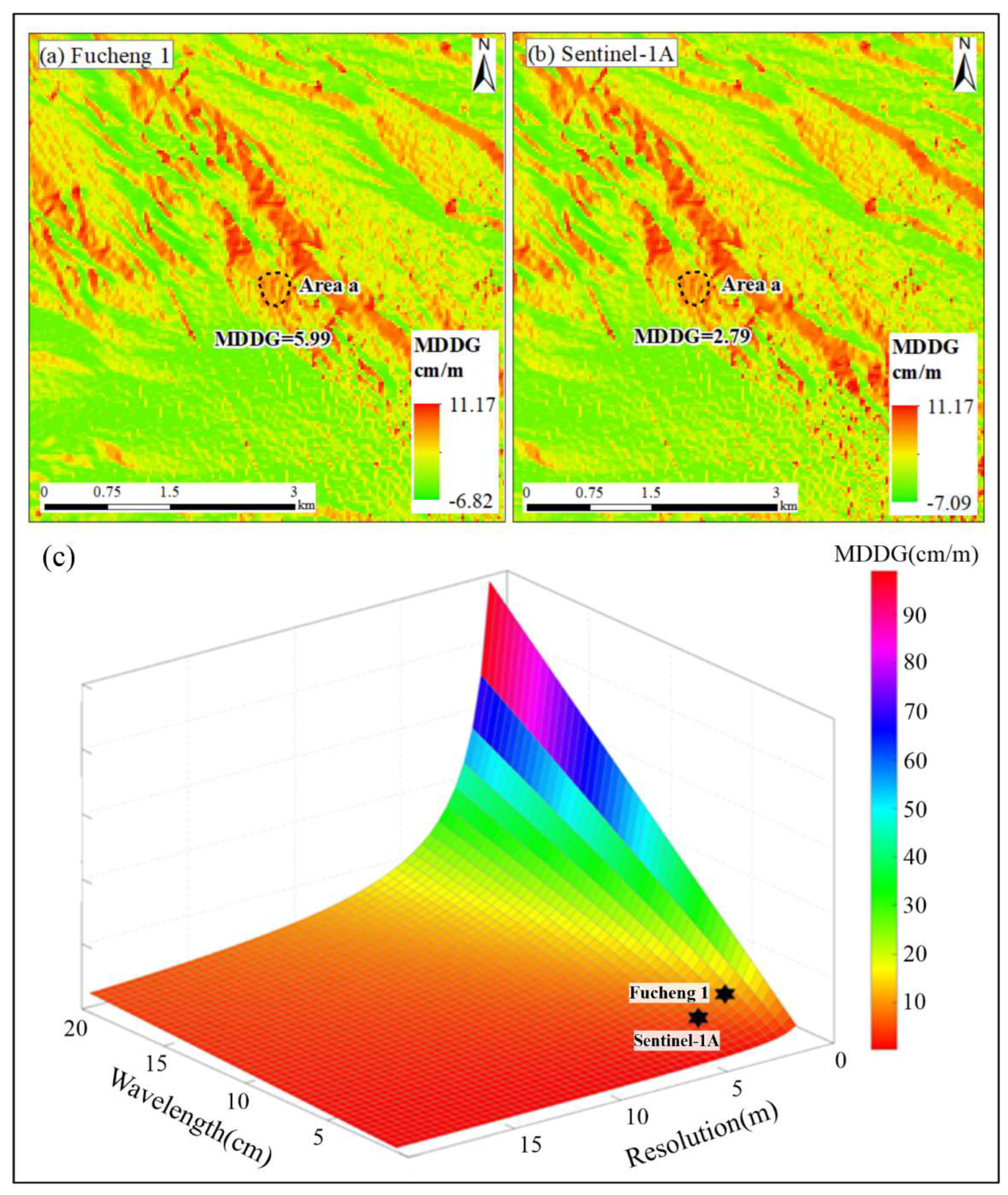
| Sentinel-1A | Fucheng 1 | |
|---|---|---|
| Satellite Mass Level | 2280 kg (Medium satellite) | 300 kg (Mini-satellite) |
| Satellite Band | C | C |
| Time Span | 20 September 2023–7 November 2023 | 19 September 2023–2 November 2023 |
| Imaging Mode | TOPS | Stripmap |
| Pixel Size in Azimuth | 13.94 m | 1.67 m |
| Pixel Size in Range | 9.32 m | 1.25 m |
| Swath Width | 250 km | 25 km |
| Spatial Baseline | 49~230 m | 8~30 m |
| Revisiting Period | 12 d | 11 d |
| Orbiting Precision | Better than 5 cm | Better than 10 cm |
| Orbit Direction | Ascending | Ascending |
| Number of Images | 5 | 5 |
Disclaimer/Publisher’s Note: The statements, opinions and data contained in all publications are solely those of the individual author(s) and contributor(s) and not of MDPI and/or the editor(s). MDPI and/or the editor(s) disclaim responsibility for any injury to people or property resulting from any ideas, methods, instructions or products referred to in the content. |
© 2024 by the authors. Licensee MDPI, Basel, Switzerland. This article is an open access article distributed under the terms and conditions of the Creative Commons Attribution (CC BY) license (https://creativecommons.org/licenses/by/4.0/).
Share and Cite
Feng, S.; Dai, K.; Sun, T.; Deng, J.; Tang, G.; Han, Y.; Ren, W.; Sang, X.; Zhang, C.; Wang, H. Mini-Satellite Fucheng 1 SAR: Interferometry to Monitor Mining-Induced Subsidence and Comparative Analysis with Sentinel-1. Remote Sens. 2024, 16, 3457. https://doi.org/10.3390/rs16183457
Feng S, Dai K, Sun T, Deng J, Tang G, Han Y, Ren W, Sang X, Zhang C, Wang H. Mini-Satellite Fucheng 1 SAR: Interferometry to Monitor Mining-Induced Subsidence and Comparative Analysis with Sentinel-1. Remote Sensing. 2024; 16(18):3457. https://doi.org/10.3390/rs16183457
Chicago/Turabian StyleFeng, Shumin, Keren Dai, Tiegang Sun, Jin Deng, Guangmin Tang, Yakun Han, Weijia Ren, Xiaoru Sang, Chenwei Zhang, and Hao Wang. 2024. "Mini-Satellite Fucheng 1 SAR: Interferometry to Monitor Mining-Induced Subsidence and Comparative Analysis with Sentinel-1" Remote Sensing 16, no. 18: 3457. https://doi.org/10.3390/rs16183457
APA StyleFeng, S., Dai, K., Sun, T., Deng, J., Tang, G., Han, Y., Ren, W., Sang, X., Zhang, C., & Wang, H. (2024). Mini-Satellite Fucheng 1 SAR: Interferometry to Monitor Mining-Induced Subsidence and Comparative Analysis with Sentinel-1. Remote Sensing, 16(18), 3457. https://doi.org/10.3390/rs16183457







